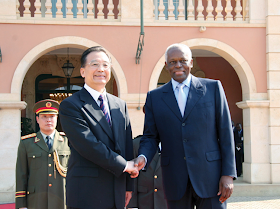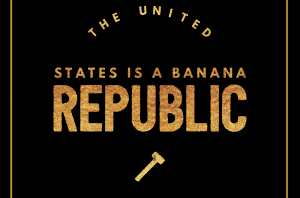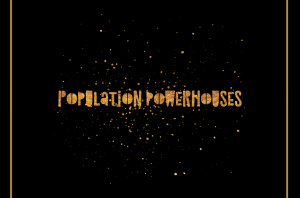
The story of China in Angola has been told so often, and almost always those telling the story neglect the larger context of how Chinese banks fit into a pre-existing system whereby Angolans financed so much of their government spending for so long: through oil-backed loans from Western banks. What was really going on between 2003 and 2005 when China’s first oil-backed loan was signed in Angola? Below, an excerpt from The Dragon’s Gift (pp. 273-277) where I answer that question. Tomorrow I will refer back to this excerpt when I comment on a new report on China International Fund.
Oil-rich Angola is a country deeply cursed with natural resources — a tropical paradise laced with landmines and hemorrhagic fever, bauxite and gold. Angola also features as one of the prime exhibits in the chorus of condemnation about China’s engagement in Africa. We start this chapter with a closer look at this relationship. Unpeeling its many layers can lay bare some of the myths and realities of China’s engagement in Africa.
First, a brief history. Angola’s war for independence became an East–West conflict after Portugal abruptly gave up power in 1975. The Soviet Union and Cuba stepped in to support the new socialist government. The United States and apartheid South Africa aided the rebels. With the end of the Cold War, Angola’s proxy struggle morphed into a fight for control over blood diamonds, natural gas, and oil. The death in battle of the sixty-seven-year-old rebel leader Jonas Savimbi in 2002 finally allowed Angolans to end more than forty years of war and limp toward something resembling normalcy.
The Angolan government financed the war with a shadowy system of off-budget accounts that sometimes sloshed with oil revenues and sometimes ran dry. Over the years, the once Marxist leadership grew wealthy on a toxic diet of oil money and kickbacks from weapon sales. “Corruption is widespread throughout society,” the IMF wrote in a report leaked to the press./1 Ten out of every fifty infants born in Angola died before reaching their fifth birthday.
As the war drew to an end, Angola was badly behind on its debts. They owed more than two billion dollars to the Paris Club, nineteen wealthy creditor nations that meet informally to decide on bilateral debt issues. But they also owed more than eight billion to other creditors, some (such as a group of Russians) even shadier than the Angolan government itself. These moneylenders were clamoring for payment; some tried to seize government assets outside the country.
Enter China. The story that follows has some of the flavor of the classic 1950 film Rashomon, in which an encounter in the woods is retold, very differently, through the eyes of each participant./2 The conventional wisdom goes something like this. After the war, the IMF and the West decide to clean up Angola. The IMF insists that Angola improve oil revenue transparency and open its tangled accounts for inspection. Backed into a corner by 2004, the Angolans are about to agree, when China steps in, offering Angola billions of dollars of aid. Flush with cash, Angola turns its back on the IMF, taking China’s offer, which comes with no strings attached. “Angola is avoiding pressure to clean up corruption thanks to aid from China,” concludes a typical news item./3 Reports on China in Africa rarely fail to mention this cautionary tale. It is always obvious who plays the villain.
Rashomon is a film about truth and perception. Let us complicate this simple tale by telling it again, from a different point of view. In this story, José Eduardo dos Santos, Angola’s president since 1979, begins using the state-owned oil company Sonangol as a “cash cow” to finance the war, political payoffs, and other state expenses. By the end of the war, Angola has taken out an estimated forty-eight oil-backed loans, nearly all arranged, very profitably, by respectable Western banks: BNP Paribas of France, Standard Chartered of the UK, Commerzbank of Germany, and so on.
The IMF tries to wean Angola off its risky diet of expensive short-term loans. They ask Angola to commit to a host of reforms. For example, Angola’s April 2000 reform program contains forty-four conditions and benchmarks, including raising income taxes and liberalizing trade. If they keep on track for six months, they earn a seal of approval that could then make them eligible for debt rescheduling through the Paris Club, and international aid.
Angola negotiates at least four IMF programs between 1995 and 2004, but fails to stick with any of them. In 2001, with the war still ongoing, Angola again promises the IMF it will reform: create greater transparency in oil revenues, turn over customs management to a British firm (Crown Agents), reduce fuel subsidies, raise water rates, rein in borrowing, and privatize several money-losing enterprises.
However, Angola again fails the test — not only on the transparency issue (which the IMF agrees is improving but still has far to go), but on the other conditions, particularly its unwillingness to stop borrowing. The international watchdog group Global Witness estimates that between September 2000 and October 2001 alone, international banks provided Angola up to $3.55 billion in seven secretive, high-cost, oil-backed loans.
For a while the Paris Club continues to present a united front to Angola’s attempts to get relief on its overdue loans. They want Angola to successfully complete at least one IMF program. But then in 2003 the Germans break rank, settling a debt reduction deal unilaterally. This allows Germany’s companies to return to Angola, and Germany to extend new export credits. Meanwhile, the French bank Société Générale helps Angola out with another large oil-backed loan for $1.15 billion.
Now we see China enter this crowded room with an oil-backed loan of its own. The $2 billion line of credit offered by China Eximbank in 2004 is unlike most other oil-backed loans, however. First, it costs less. Angola, a relatively high-risk country, has been borrowing at a premium of up to 2.5 percent over LIBOR (the London Inter-Bank Offered Rate, the benchmark interest rate for international finance). The Chinese loan is at LIBOR plus 1.5 percent. Second, it has a grace period of five years, with payment over a further twelve years, far longer than the European banks’ normal term of four or five years, without any grace period. “This is not foreign aid,” a senior Chinese diplomat tells me. “But it is a very good rate.”
As we already know, the most unusual feature of the line of credit is that it will be used entirely for infrastructure projects, the same oil-for-infrastructure model Japan used in China three decades before./4 Four decades of war left Angola’s road system “in a shocking state of disrepair,” a World Bank team reports./5 Bombs destroyed more than 300 bridges. Rural roads and farming fields were planted with landmines. Urban infrastructure “dramatically deteriorated,” streets were “in a state of virtual collapse.” Raw sewage spilled out of the open gutters during heavy rains and ran down the alleys of chaotic shanty towns. Angolans badly need infrastructure. To get aid funding from the West, their leaders are being asked, not unreasonably, to end the cozy system of oil finance that served as a substitute for a proper budget and a central bank all these years./6 The negotiations with the IMF were not even about finance. “We are not looking for money,” the Angolan Finance Minister said about the IMF. “We are looking for a seal of approval that we can present to creditors in order to reschedule our debt.”/7
This alternative story is more complicated, but this brings it closer to reality than the first story, with its shadow play of good and evil. The first story also misses something else. There is a second act. Within months of the Chinese loan, a group of Western banks, including Barclays and Royal Bank of Scotland, arrange an even larger oil-backed loan for $2.35 billion, at 2.5 percent over LIBOR, with repayment over five years. “We were very excited,” one of the bankers told a trade magazine, which called the deal “the largest oil backed transaction in the entire history of the structured trade finance market.”/8 In late 2005, Angola asks the French group Crédit Agricole (Calyon) to arrange another $2 billion loan; sixteen international banks participate. The United States Eximbank provides credits of $800 million for Angola to buy six Boeing aircraft./9 China Eximbank makes two more oil-for-infrastructure loans, of $2 billion and $500 million, between 2005 and 2007. Again, out of the crowd, only the Chinese loans make headlines.
Then, to the surprise of the Paris Club, the Angolans decide to simply pay off their debts with their booming oil revenues. Transparency improves, even without the conditionality of the Western donors: with technical assistance from the IMF, the Angolans finally begin to publish a fairly complete account of their oil revenues and expenditures on the website of their Ministry of Finance./10 There is still enormous corruption, but roads, clinics, and schools are being built. Although some believed the Chinese loans arrived in cash, they were wrong, as we have seen from our study of China’s unusual resource-backed infrastructure loans. A second look reveals that it was Western banks that gave loans without requiring transparency, and Western companies that exported Angolan oil, providing cash flows for the ruling party. The Chinese deal was not without risks, but it was also revolutionary for the country: for the first time, there was a hope that some of Angola’s riches might actually be translated directly into development projects.




